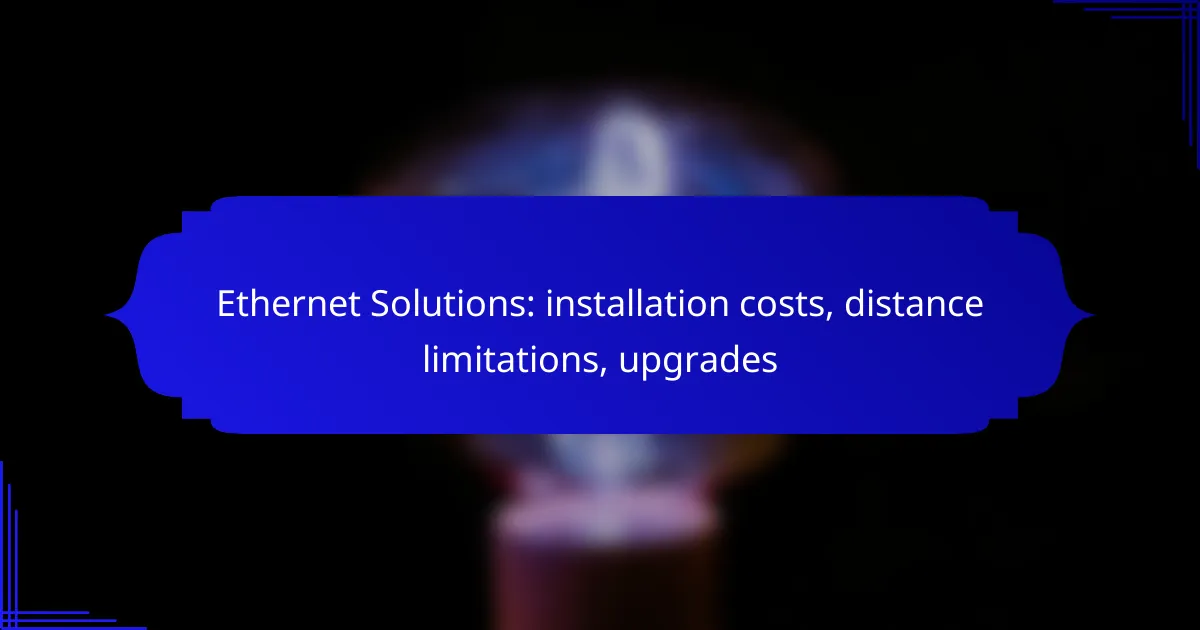When considering Ethernet solutions, it’s essential to understand the installation costs, which in New Zealand can range from NZD 1,000 to NZD 5,000 based on various factors. Additionally, Ethernet cables have a distance limitation of 100 meters for optimal performance, making it crucial to plan installations accordingly. Upgrading existing infrastructure may also be necessary to enhance performance and capacity, requiring careful assessment and selection of compatible hardware.

What are the Ethernet installation costs in New Zealand?
In New Zealand, Ethernet installation costs typically range from NZD 1,000 to NZD 5,000, depending on the complexity of the setup and the specific requirements of the installation. Factors such as the type of Ethernet cabling, labor costs, and additional equipment can influence the final price.
Average installation cost range
The average cost for installing Ethernet in New Zealand generally falls between NZD 1,500 and NZD 3,500 for standard residential setups. For larger commercial installations, costs can escalate to NZD 5,000 or more, especially if extensive cabling or specialized equipment is needed. It’s advisable to obtain multiple quotes to ensure competitive pricing.
Factors influencing installation costs
Moreover, the choice of network switches, routers, and other hardware can add to the overall expense. Planning for future upgrades or expansions may also influence initial costs, as investing in higher-quality equipment can yield long-term savings.
Cost comparison with other networking solutions
When comparing Ethernet installation costs to wireless networking solutions, Ethernet tends to have a higher upfront installation cost but offers more reliable performance and lower long-term maintenance costs. Wireless setups may have lower initial costs, but they often require ongoing investments in equipment and may incur additional costs for signal boosters or repeaters.
For instance, a basic wireless installation might start around NZD 500, but performance can degrade with distance and interference, leading to potential additional costs for upgrades. In contrast, Ethernet provides consistent speeds and reliability, making it a preferred choice for businesses and high-demand environments.

What are the distance limitations of Ethernet cables?
Ethernet cables have specific distance limitations that affect their performance and reliability. Generally, standard Ethernet cables can transmit data effectively over distances up to 100 meters, beyond which signal degradation occurs.
Maximum distance for standard Ethernet
The maximum distance for standard Ethernet, specifically for Category 5e and Category 6 cables, is typically 100 meters (328 feet). This distance includes the length of the cable run from the switch or router to the device, as well as any patch cables used. For longer distances, alternative solutions are necessary.
Impact of distance on signal quality
As the distance increases beyond the recommended limits, the signal quality diminishes, leading to potential data loss and slower speeds. Factors such as electromagnetic interference and cable quality can exacerbate these issues. Users may experience latency or connectivity problems if the cable runs exceed 100 meters.
Solutions for extending Ethernet range
To extend the range of Ethernet connections, consider using network switches or repeaters, which can boost the signal over longer distances. Fiber optic cables are another effective solution, as they can transmit data over several kilometers without significant signal loss. Additionally, Power over Ethernet (PoE) extenders can help maintain power and data transmission over longer runs.

How to upgrade existing Ethernet infrastructure?
Upgrading existing Ethernet infrastructure involves replacing or enhancing current equipment to improve performance and capacity. This process typically includes assessing current needs, selecting compatible hardware, and ensuring proper installation and configuration.
Steps for upgrading Ethernet equipment
Start by evaluating your current Ethernet setup, identifying bottlenecks, and determining your performance requirements. Next, select new switches, routers, or cabling that meet the latest standards, such as Cat6 or Cat6a for higher speeds. Finally, plan the installation process, which may involve downtime, so inform users and schedule the upgrade during off-peak hours.
Recommended brands for Ethernet upgrades
Several reputable brands offer reliable Ethernet upgrade solutions. Cisco and Netgear are well-known for their robust switches and routers, while TP-Link provides cost-effective options for smaller networks. For cabling, Belden and Panduit are recognized for their high-quality Ethernet cables that ensure optimal performance.
Cost considerations for upgrades
The cost of upgrading Ethernet infrastructure can vary widely based on the scale of the project and the equipment chosen. Basic upgrades may start in the low hundreds of USD, while comprehensive overhauls can reach several thousand USD. Always factor in installation costs, which can add an additional 20-30% to the total budget, especially if professional help is required.

What are the prerequisites for Ethernet installation?
Before installing Ethernet, it’s essential to understand the prerequisites, which include site assessments and the necessary tools. Proper preparation ensures a smooth installation process and optimal network performance.
Site assessment requirements
A thorough site assessment is critical for successful Ethernet installation. This involves evaluating the physical environment, including the layout of the building, potential obstacles, and existing infrastructure. Considerations such as distance limitations and the type of Ethernet cabling needed (e.g., Cat5e, Cat6) must be addressed.
Additionally, check for compliance with local building codes and regulations. Ensure that the installation site has adequate power supply and ventilation, especially for network equipment that may generate heat.
Necessary tools and equipment
To install Ethernet effectively, certain tools and equipment are required. Basic tools include a cable tester, crimping tool, and wire strippers. For larger installations, a network switch, patch panels, and appropriate cabling (like Cat6 or fiber optic) may be necessary.
It’s also advisable to have safety gear, such as gloves and goggles, especially when working in ceilings or attics. Proper labeling materials for cables can help maintain organization and simplify future troubleshooting.

How to choose the right Ethernet solution?
Choosing the right Ethernet solution involves assessing your specific business requirements, including speed, distance, and budget. Understanding the various types of Ethernet and their limitations will help you make an informed decision that meets your operational needs.
Factors to consider for business needs
When selecting an Ethernet solution, consider the bandwidth requirements of your applications. For instance, high-definition video conferencing or large data transfers may necessitate higher speeds, while basic web browsing can function adequately with lower bandwidth.
Distance limitations are another critical factor. Standard Ethernet can typically cover up to 100 meters, while fiber optic solutions can extend this range significantly, often exceeding several kilometers. Evaluate your physical layout to determine the best fit.
Budget constraints also play a vital role. While fiber optics may offer superior performance, they often come with higher installation costs compared to copper Ethernet solutions. Weigh the long-term benefits against the initial investment to find the right balance.
Comparison of Ethernet types
There are several types of Ethernet solutions, each with its unique characteristics. For example, Fast Ethernet (100BASE-T) is suitable for most small to medium-sized businesses, providing speeds up to 100 Mbps over copper cabling.
Gigabit Ethernet (1000BASE-T) offers significantly higher speeds, making it ideal for environments with heavy data traffic. However, it requires more robust cabling and may have higher installation costs.
For larger enterprises or those needing extensive coverage, fiber optic Ethernet (such as 10GBASE-SR) is the best choice, offering speeds up to 10 Gbps and the ability to cover long distances. While installation can be costly, the performance benefits often justify the expense.

What are the emerging trends in Ethernet technology?
Emerging trends in Ethernet technology focus on increased speeds, enhanced integration with smart technologies, and strategies for future-proofing installations. These advancements aim to meet the growing demands for bandwidth and connectivity in various sectors.
Advancements in Ethernet speeds
Ethernet technology is evolving rapidly, with speeds now reaching up to 400 Gbps and beyond. This increase allows for more data to be transmitted simultaneously, which is crucial for data centers and enterprise networks that require high performance.
When considering upgrades, it’s essential to evaluate existing infrastructure compatibility. Many organizations are transitioning from 1 Gbps to 10 Gbps as a standard, which can significantly improve network efficiency without extensive overhauls.
Future-proofing Ethernet installations
Future-proofing involves designing Ethernet installations that can accommodate higher speeds and new technologies without major renovations. This can include using fiber optic cables, which support higher bandwidths over longer distances compared to traditional copper cabling.
Investing in modular equipment can also help ensure that systems can be easily upgraded as technology advances. Organizations should consider scalable solutions that allow for incremental upgrades rather than complete replacements, which can be costly.
Integration with smart technologies
As smart technologies become more prevalent, Ethernet is increasingly integrated into IoT devices and smart building systems. This integration enhances connectivity and allows for better data management and automation.
When implementing smart technologies, ensure that the Ethernet infrastructure can handle the additional load. Prioritize devices that support Power over Ethernet (PoE) to simplify installations and reduce the need for separate power sources.
